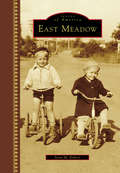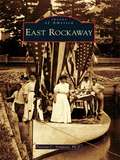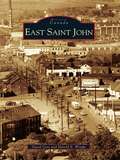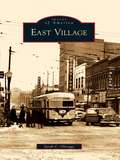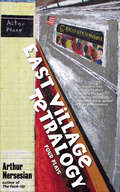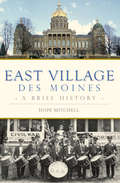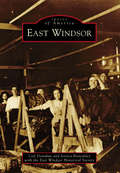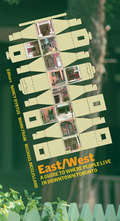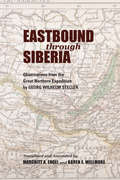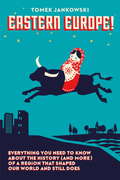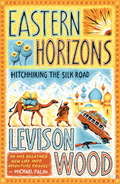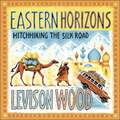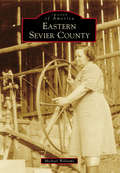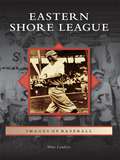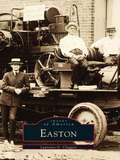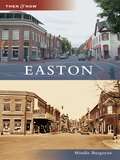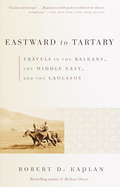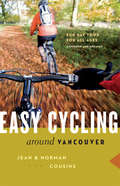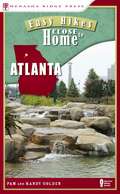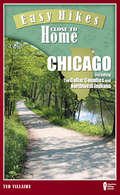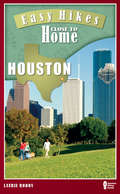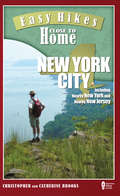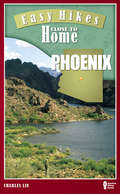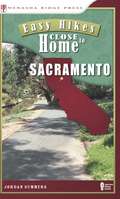- Table View
- List View
East Meadow (Images of America)
by Scott M. EckersFollowing World War II, East Meadow developed into a suburban paradise some 20 miles east of New York City. The hamlet's name was derived from its proximity to the colonial settlement at Hempstead and the topography of the Hempstead Plains that covered much of present-day Nassau County. East Meadow was once known for herding sheep, raising cattle, and growing potatoes--livestock frequently outnumbered the human population. Large farming estates of the Barnum, Carman-Lowden, and Fish families drove the local economy and existed alongside smaller farms and businesses that dotted the colonial-era roads. East Meadow was also home to high-society Gilded Age mansions, dangerous automobile races, stylish polo and golf clubs, and famous residents such as Eleanor Roosevelt, Joseph J. Lannin, and Alva Vanderbilt Belmont. Proximity to Mitchel Air Force Base and Roosevelt Field placed East Meadow directly under the path of important airplane firsts, such as Charles A. Lindbergh's 1927 transatlantic flight.
East Rockaway (Images of America)
by Patricia C. SympsonEast Rockaway is a village on the south shore of Nassau County, Long Island. In 1689, Joseph Haviland built a gristmill, which became the center of economic, social, and cultural life for the next century and a half, until the arrival of the railroad changed the focus of East Rockaway. Shipping waned, milling became obsolete, and new families arrived as East Rockaway entered the 20th century. A picturesque community, the village was incorporated in an effort by the village fathers to fight against unnecessary taxation. Today East Rockaway is a suburban community, with many of its residents employed locally, and it embraces its portrayal as a somnolent, quiet village.
East Saint John (Historic Canada)
by Harold E. Wright David GossEast Saint John, affectionately called the "East Side," became a part of the City of Saint John in 1967. For decades prior to its merger, the city and east side community of the Parish of Simonds cooperated in many areas of municipal service. East Saint John contained many industries, including the dry dock, Foleys Pottery, and McAvitys, and later K. C. Irving's oil refinery at Silver Falls. During World War II , Fort Mispec was established at Mispec Point, and in 1970, the fort site became Irving Oil's Canaport. More than just an industrial area, East Saint John was the site of recreational fishing and boating and home to the neighbourhoods of Forest Hills, Glen Falls, Champlain Heights, and Jean and Belgrave Streets. East Saint John was also the home of the Moosepath raceway, Exhibition Park, and the Simonds Arena. Rothesay Avenue was the commercial heart of the east side until the 1970s, when new malls and shopping centers opened nearby.
East Village
by Sarah C. OltroggeA little neighborhood in the shadow of the state capitol, East Village in downtown Des Moines used the statehouse dome as a backdrop to establish itself in what was low, mostly unusable land along the Des Moines River. Just after the dawn of the 20th century, the neighborhood burgeoned with blue-collar industry and corner stores, while boasting the convenient use of railroads for industrial development and travel. It seemed to be in competition with the west side, where the insurance industry and wealthy neighborhoods blossomed on high ground. By midcentury, though, East Village suffered as a mobile population chose suburban shopping malls over traditional mom-and-pops. By 1990, buildings were in disrepair, and crime was increasing. A group of dedicated individuals came together and, with assistance and cooperation from the city, brought East Village back into focus, with a clear urban identity that sparked a renewed sense of pride.
East Village Tetralogy: Four Plays
by Arthur Nersesian"Nersesian is this generation's Mark Twain and the East River is his Mississippi."--Jennifer Belle, author of High Maintenance"Award-winning playwright Arthur Nersesian has woven an effective dramatic form through four plays, each quite funny in its own way. Each yields very powerful human results while subtly investigating the major social issues of our time."--Evangelina Borges, Trying Time PressNersesian's cult status has grown from the success of his novels, and here for the first time his equal skills as a playwright are revealed to a hungry public. Three of the four plays in East Village Tetralogy have been staged off-Broadway in New York City. The four plays included in this volume are: Rent Control East Village Writer's Bloc Plea Bargains Spare Change
East Village, Des Moines: A Brief History (Brief History)
by Hope MitchellEast Village was not always the fashionable destination it is today. When the first settlers arrived in 1843 on the muddy banks of the Des Moines River, it was in direct violation of a treaty with the local natives. The settlement grew so quickly that by 1855, the fledgling city had been selected to be the state capital, and the building was constructed in East Village. The next century saw rivalries with the western half of the city, the birth and battle of one of the city's largest red-light districts and the construction of some of Des Moines' most prized historic treasures. Historian Hope Mitchell investigates the people and events that shaped the culture and landscape of Des Moines' most dynamic neighborhood.
East Windsor (Images of America)
by Ceil Donahue East Windsor Historical Society Jessica BottomleyThe town of East Windsor, incorporated in 1768, is situated in the center of northern Connecticut, with the Connecticut River as its western border. In the early 1600s, a few settlers crossed the “great river” to establish farms. East Windsor’s rich and productive farmland served them well. Five distinct villages, each historically different, highlight the rich and diverse heritage of the town. Warehouse Point, with its proximity to the river, was a vital shipping and transportation hub. Scantic was started by a strong religious community devoted to God and families. Broad Brook had access to the millpond, which spurred the prosperous Broad Brook Company woolen mill. Melrose, established by farming families, is rooted in its agrarian past. Windsorville’s location on the banks of Ketch Brook triggered villagers to build a dam and erect mills. Through it all ran the trolley line, which linked the villages and town with the surrounding area.
East/West: A Guide to Where People Live in Downtown Toronto
by Nancy Byrtus Mark FramEast/West is a guided tour of old stories and fresh perspectives on the architecture and planning of housing and urba n development in central Toronto - including both success stories and perennial problems. Specially prepared maps, over 120 photos, and scores of essays cover more than a hundred sites, neighbourhoods and current issues. The editors are practising professionals in architecture, planning, and historic preservation in Canada.
Eastbound through Siberia: Observations from the Great Northern Expedition
by Georg Wilhelm Steller“Traveling with Steller as he botanizes his way across Siberia is part wilderness adventure, part open air museum visit, and a valuable historical window.” —Erika Monahan, author of The Merchants of SiberiaIn the winter of 1739, Georg Steller received word from Empress Anna of Russia that he was to embark on a secret expedition to the far reaches of Siberia as a member of the Great Northern Expedition. While searching for economic possibilities and strategic advantages, Steller was to send back descriptions of everything he saw. The Empress’s instructions were detailed, from requests for a preserved whale brain to observing the child-rearing customs of local peoples, and Steller met the task with dedication, bravery, and a good measure of humor. In the name of science, Steller and his comrades confronted horse-swallowing bogs, leaped across ice floes, and survived countless close calls in their exploration of an unforgiving environment. Not stopping at lists of fishes, birds, and mammals, Steller also details the villages and the lives of those living there, from vice-governors to prostitutes. His writings rail against government corruption and the misuse of power while describing with empathy the lives of the poor and forgotten, with special attention toward Native peoples.“Not only showcases Steller the botanist but also reveals him as an admirable human being with a great sense of humor who managed to keep an upbeat attitude in the most trying circumstances.” —Eckehart J. Jäger“What emerges is a remarkable window into life—both human and animal—in 18th century Siberia.” —The Birdbooker Report“Adds fascinating details to the life of Steller and his travels and discoveries just before joining Bering in Kamchatka to set sail.” —Anchorage Daily News
Eastern Europe!
by Tomek E. JankowskiWhen the legendary Romulus killed his brother Remus and founded the city of Rome in 753 BCE, Plovdiv -- today the second-largest city in Bulgaria -- was already thousands of years old. Indeed, London, Paris, Berlin, Vienna, Madrid, Brussels, Amsterdam are all are mere infants compared to Plovdiv. This is just one of the paradoxes that haunts and defines the New Europe, that part of Europe that was freed from Soviet bondage in 1989 which is at once both much older than the modern Atlantic-facing power centers of Western Europe while also being in some ways much younger than them. Eastern Europe! is a brief and concise (but informative) introduction to Eastern Europe and its myriad customs and history. Even those knowledgeable about Western Europe often see Eastern Europe as terra incognita, with a sign on the border declaring "Here be monsters." This book is a gateway to understanding both what unites and separates Eastern Europeans from their Western brethren, and how this vital region has been shaped by, but has also left its mark on, Western Europe, Central Asia, the Middle East and North Africa. Ideal for students, businesspeople, and those who simply want to know more about where Grandma or Grandpa came from, Eastern Europe! is a user-friendly guide to a region that is all too often mischaracterized as remote, insular, and superstitious.Illustrations throughout include: 40 photos, 40 maps and 40 figures (tables, charts, etc.)
Eastern Great Lakes Lighthouses: The Life and History of America's Waterways)
by Ray JonesThe stories of the most significant lighthouses on Lakes Ontario, Erie, and Huron--on both the American and Canadian sides--come alive in the stirring profiles contained in these pages. Descriptions of forty-three [count may change] lighthouses, including eighteen [count may change] on the Canadian side of the lakes, contain directions to the lights and details on visiting them.
Eastern Horizons: Shortlisted for the 2018 Edward Stanford Award
by Levison WoodLevison Wood was only 22 when he decided to hitch-hike from England to India through Russia, Iran, Afghanistan and Pakistan, but he wasn't the conventional follower of the hippy trail. A fascination with the deeds of the early explorers, a history degree in the bag, an army career already planned and a shoestring budget of £750 - including for the flight home - he was determined to find out more about the countries of the Caucasus and beyond - and meet the people who lived and worked there.EASTERN HORIZONS is a true traveller's tale in the tradition of the best of the genre, populated by a cast of eccentric characters; from mujahideen fighters to the Russian mafia. Along the way he meets some people who showed great hospitality, while others would rather have murdered him...
Eastern Horizons: Shortlisted for the 2018 Edward Stanford Award
by Levison WoodAward-winning TV adventurer and travel writer's enthralling account of his youthful expedition to Central Asia.Levison Wood was only 22 when he decided to hitch-hike from England to India through Russia, Iran, Afghanistan and Pakistan, but he wasn't the conventional follower of the hippy trail. A fascination with the deeds of the early explorers, a history degree in the bag, an army career already planned and a shoestring budget of £750 - including for the flight home - he was determined to find out more about the countries of the Caucasus and beyond - and meet the people who lived and worked there.EASTERN HORIZONS is a true traveller's tale in the tradition of the best of the genre, populated by a cast of eccentric characters; from mujahideen fighters to the Russian mafia. Along the way he meets some people who showed great hospitality, while others would rather have murdered him...This book confirms that Levison Wood, Winner of the 2016 Edward Stanford Adventure Travel Book Of The Year Award, has indeed 'breathed new life into adventure travel ' (Michael Palin) (P)2017 Hodder & Stoughton Limited
Eastern Sevier County (Images of America)
by Michael WilliamsEastern Sevier County rests in the foothills of the Great Smoky Mountains National Park. The area is home to the small communities of Foxfire Mountain, Pittman Center, Jones Cove, Richardson's Cove, Locust Ridge, and Pearl Valley. Foxfire Mountain is best known today for the adventure park and agri-tourist destination brought to life by the Postlewaite family, yet it also boasts a colorful history that includes Benjamin Owens, a judge notorious for hanging convicts from an oak tree on his property. Locust Ridge is the birthplace of country music legend Dolly Parton, and it has been reported that her father compensated the attending physician who delivered Dolly with a bag of cornmeal. Pittman Center, originally a Cherokee hunting ground, is now the largest community in this portion of the county. Strangely, the town is named for Dr. Eli Pittman of New York, who assisted local minister John Burnett with fundraising to build a school to serve the area. Pittman Center is now a favorite destination for those enjoying the Great Smoky Mountains National Park.
Eastern Shore League (Images of Baseball)
by Mike LambertBetween 1922 and 1949, the citizens of Delmarva enjoyed watching baseball the way it was meant to be played. Loyal Eastern Shore baseball enthusiasts were blessed to witness three eras of professional class "D" baseball, supporting their favorite teams, including the Parksley Spuds, Salisbury Indians, and Dover Orioles. The local faithful cheered on homegrown legends such as Frank "Home Run" Baker and Jimmie Foxx, both destined for enshrinement in the National Baseball Hall of Fame in Cooperstown, New York.
Easton (Images of America)
by Laurence G. ClaggettIn the early part of the 18th century, Talbot County on Maryland's Eastern Shore was restructured in size and boundary, requiring the designation of a new county seat. Groups from the Wye River to Oxford competed vigorously to have their town win the honor. But the selection committee, with manifestpartiality, decided upon the geographical center of the new county: a remote field cultivated and thenabandoned by its native residents. Here was born thetown that would eventually be known as Easton. Telling the story of the original Talbot CourtHouse, the market, early schools, churches, andbusinesses, this fascinating visual history documentsan era of significant change for the town in the early 20th century. Improved roads and transportationallowed the widespread population of the county to come to town; friends and family members could meetmore often, and a sense of community identity began to grow.
Easton (Then and Now)
by Mindie BurgoyneNamed Easton in 1788, the principal town on Maryland's Eastern Shore grew to be its center of government and commerce. These images chart Easton's transformation into Maryland's eastern hub for the arts, culture, and entertainment, revealing the town's treasure trove of Victorian and Colonial buildings, historic streetscapes, and the oldest Quaker meetinghouse in the United States.
Eastward to Tartary
by Robert D. KaplanEastward to Tartary, Robert Kaplan's first book to focus on a single region since his bestselling Balkan Ghosts, introduces readers to an explosive and little-known part of the world destined to become a tinderbox of the future.Kaplan takes us on a spellbinding journey into the heart of a volatile region, stretching from Hungary and Romania to the far shores of the oil-rich Caspian Sea. Through dramatic stories of unforgettable characters, Kaplan illuminates the tragic history of this unstable area that he describes as the new fault line between East and West. He ventures from Turkey, Syria, and Israel to the turbulent countries of the Caucasus, from the newly rich city of Baku to the deserts of Turkmenistan and the killing fields of Armenia. The result is must reading for anyone concerned about the state of our world in the decades to come.
Easy Cycling Around Vancouver
by Norman Cousins Jean CousinsWhether you bicycle for fitness, pleasure, transportation or all of the above, Easy Cycling around Vancouver features dozens of routes to discover across the Lower Mainland and northwestern Washington State. From Squamish to Bellingham, Richmond to Agassiz, Jean and Norman Cousins guide you along winding backroads and quiet country lanes, pointing out the best cafes and swimming holes as well as local flora and historic sites.This updated and expanded second edition includes:* forty-five tours (nine all-new ones) ranging from 20 to 45 km long* concise, easy-to-follow maps and route descriptions* helpful tips about cycling basics, safety and trip planningTry a flat, scenic trail with the kids or combine several tours to make up a multi-day trip. Ride right from your front door or take a bus, train or ferry to the starting point. Whatever your cycling interest, Easy Cycling around Vancouver will fit the bill.
Easy Hikes Close to Home: Atlanta
by Pam Golden Randy GoldenDay hiking in Atlanta and the surrounding areas has never been better - or easier. This guide, compiled by avid hikers Randy and Pam Golden, introduces residents and visitors to the area's best easy day treks. Carefully researched on foot, and filled with detailed trail notes, the book helps novice hikers discover their options with concise at-a-glance information highlighting factors such as location, access, directions, distance, and scenery. Included are both newly established trails and older trails ripe for rediscovery.
Easy Hikes Close to Home: Chicago
by Ted VillaireCarefully researched on foot by avid hiker Ted Villaire, and filled with detailed trail notes, Easy Hikes Close to Home: Chicago helps novice hikers discover their options with concise at-a-glance information. The guide, which is lightweight and extremely easy to carry on the trail, highlights factors such as location, access, directions, distance, and scenery. Included are both newly established trails and older trails ripe for rediscovery.
Easy Hikes Close to Home: Houston
by Laurie RoddyThe guide highlights factors such as location, access, directions, distance, and scenery. Included are both newly established trails and older trails ripe for rediscovery. Based on the author's own research, this handy guide introduces the best easy day hikes. Filled with detailed descriptions of each trail, Easy Hikes Close to Home: Houston helps novice hikers discover their choices with clear maps and concise at-a-glance information.
Easy Hikes Close to Home: New York City
by Christopher Brooks Catherine BrooksNew trails have been established and old trails rediscovered, making the hikes in the New York City area better than ever. Based on the authors' own research, this handy guide introduces nearly two dozen of the best easy day hikes. Filled with detailed descriptions of each trail, Easy Hikes Close to Home: New York City helps novice hikers discover their choices with clear maps and concise at-a-glance information.
Easy Hikes Close to Home: Phoenix
by Charles LiuDrawn from one of the best-selling titles in the 60 Hikes Within 60 Miles series, this compact guide can be tucked easily into a bag, backpack or back pocket. Almost 150,000 residents took part in Phoenix's Park system last year - here are 20 more outdoor escapes for family fun and light exercise. New trails have been established and old trails rediscovered, making the hikes in Phoenix and the surrounding areas better than ever. Based on the author's own research, this handy guide introduces the best easy hikes. Filled with detailed descriptions of each trail, Easy Hikes Close to Home: Phoenix helps novice hikers discover their choices with clear maps and concise at-a-glance information.
Easy Hikes Close to Home: Sacramento
by Jordan SummersCarefully researched on foot, Easy Hikes Close to Home: Sacramento introduces area residents and visitors to a wide array of the best and easy day hikes, from the atmospheric Sacramento Delta area to tranquil trails in the Cosumnes River Preserve. With detailed descriptions, novice hikers discover their choices with concise at-a-glance information highlighting details such as length, configuration, water required, exposure, trail traffic and surface, hiking time, season, facilities, scenery, and much more.
